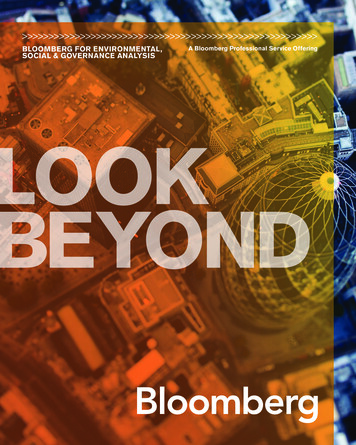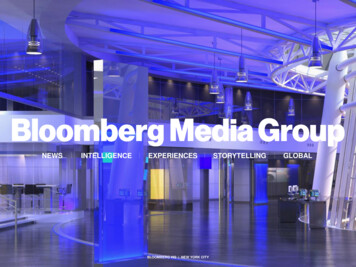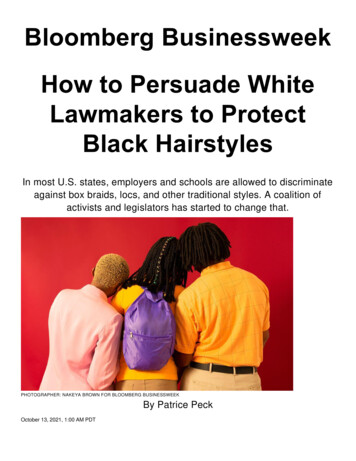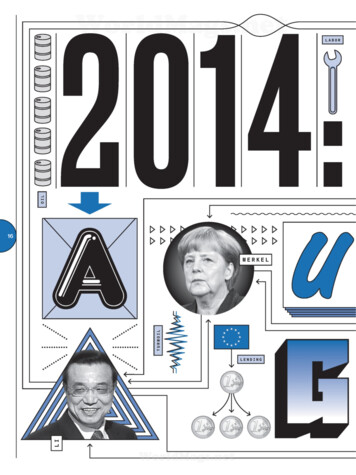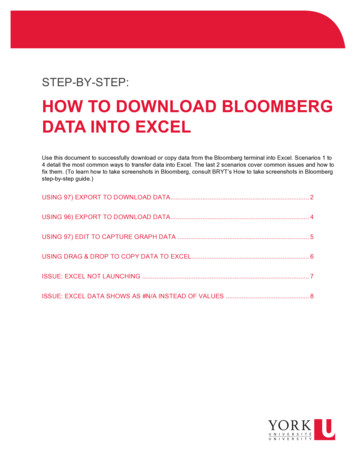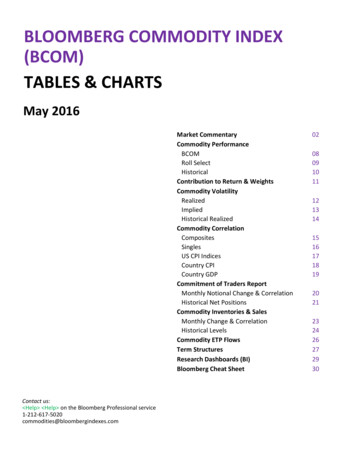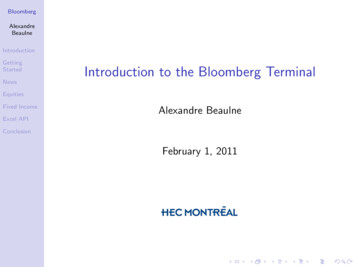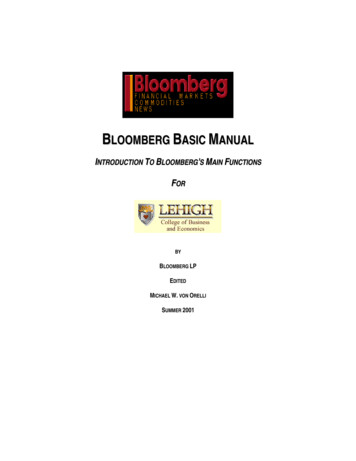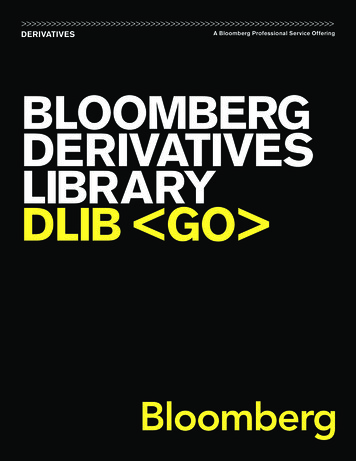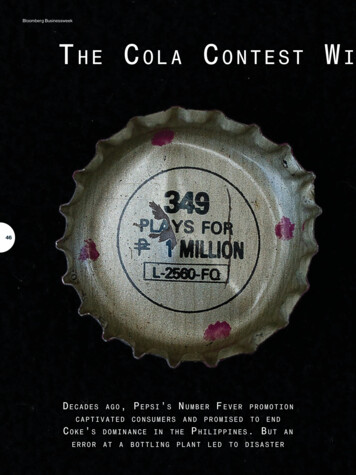
Transcription
Bloomberg Businessweek The Cola Contest Wi46Decadesago,c a pt i v a t e dCoke’serrorPepsi’s Number Feverpromotionconsumerstodominanceatainb o tt l i n gandthepromisedendP h i l i pp i n e s . B u tplantledtoandisaster
August 10, 2020th600,000 W i n n e r s47B y J e ff M a y s hPhotographsbyTWO OF PEPSI’S INFAMOUS 349 CROWNSGeric Cruz
M 48ARILY SO, A WOMAN INher early fifties with grayinghair, runs a sari-sari store out ofher one-room home in a concrete building beside a railwaytrack in Manila. In the steamy heat of a summer afternoon,shirtless children appear at her window clutching coins. Witha kind smile, she serves them warm bottles of water and RoyalTru, one of a few sodas she displays alongside tiny shampoosachets and single cigarettes. There’s one brand she refusesto sell. If someone asks for a Pepsi, her expression sours. Formore than 28 years she’s nurtured bitter resentment againstthe company. “I didn’t have a job back then,” she says, starting in on her Pepsi story.It was 6 p.m. on May 25, 1992, and So was among the 70% ofFilipinos watching the Channel 2 evening news. Then 23, shewas living in a wooden shack beside the tracks with four children under 5. Pepsi was about to announce the winning number in a promotion that had gripped the Philippines’ 65 millionpeople. Her husband, a house painter, had spent their last centavos on special “Number Fever” bottles of Pepsi, hoping oneof the three-digit numbers printed on the underside of the capswould match one of the winning numbers locked inside a vault.Across the Philippines’ 7,641 islands, ads had promisedpeople “You could be a millionaire.” A million pesos, about 68,000 in today’s dollars, was the largest prize available,611 times the country’s average monthly salary at the time.The published odds of winning that amount were 28.8 million to 1, but Pepsi had already minted 18 millionaires. Theyappeared in its ads, real as day. One, a bus driver namedNema Balmes, became known as Mrs. Pepsi after joking thatdrinking cola put her husband “in the mood.”Number Fever was the brainchild of an executive namedPedro Vergara, a Chilean who worked for the promotionsdepartment in New York. After a successful U.S. rollout, PepsiCola International Chief Executive Officer Christopher Sinclairmade it part of his strategy to fight Coca-Cola abroad. Sincebecoming the global arm’s youngest CEO at 38, Sinclair haddeveloped a reputation as a “battlefield commander.” Visiting77 countries in six months, he was dismayed to find the world’sgrocery aisles “awash with Coca-Cola red,” as Fortune put it.Pepsi hired a Mexican company, DG Consultores, to bringNumber Fever to Argentina, Chile, Guatemala, Mexico, andthe Philippines, where it truly caught fire. Monthly sales therequickly jumped from 10 million to 14 million and its marketshare from 19.4% to 24.9%. Bottling plants roared 20 hours aday, doubling their usual production. An aggressive ad campaign dominated the media, with 29 radio stations and fournewspapers circulating the winning numbers. The promotion,initially scheduled to end on May 8, was extended five weeks.By then, Number Fever was verging on Number Hysteria.Cops jailed a maid accused of stealing her employer’s winningcrown, as the bottle caps were known. Two Pepsi sales peoplewere murdered following a dispute over another crown.The night of May 25, So murmured a prayer as the blueof the television shone in her children’s eyes. When PepsiAugust 10, 2020announced the winning number, herhusband, Isagani, rifled through theircrowns and found the one: 349. A millionpesos. Her prayer had been answered.The couple danced and laughed until theTV started to rattle and a passing freighttrain drowned out their shrieks of joy.Five miles across town, Ernesto deGuzmán de Lina, a t ricycle-taxi driver,was dashing downstairs to tell hisnephew Simon Marcelo that his 349crown had just won him 50,000 pesos.Marcelo was already celebrating—he hada 349 worth 100,000 pesos, enough toquit his job as a cocktail waiter in thecity’s red-light district.Similar scenes were playing outacross the country. A bus driver hadthree 1 million-peso 349s. A mother of12 whose children went through 10 bottles of Pepsi a day had won 35 millionpesos. Winners raced to the iron gatesof Pepsi’s bottling factory in QuezonCity, just northeast of Manila, to claimtheir prizes. As the crowd grew, a secretary dialed the marketing director,Rosemarie Vera. “There seems to bemany 349 crowns in circulation amongpeople I know,” the secretary said,according to an account in the PhilippineDaily Enquirer. At 10 p.m., someone fromthe company telephoned the PhilippineDepartment of Trade and Industry andsaid a mistake had been made.Within a year, a violent consumeruprising would be under way, with riots and grenade attacksleaving dozens injured and five dead.It was perhaps the deadliest marketing disaster in history—and remains one of the business world’s great cautionarytales. “I don’t think that, from the onset, people would lookat this and say people could actually die,” says Lee Oster,a University of Idaho professor and the co- author of a risk management textbook that included Number Fever as a casestudy. “But even then, like the nuclear power industry oraviation, people have to be on top of things and realize the catastrophic events that can happen at the end.”In response to a request for comment on the eventsdescribed in this story, Pepsi said it would be unable to verifythem. “These events took place almost 30 years ago, and noneof the executives familiar with this program are at PepsiCo anymore. And given that the Philippines is just emerging from oneof the world’s longest Covid lockdowns, we have been unableto access stored records on this matter,” the company wrote.But, it said, “we deeply regret any pain and suffering our mistake caused the people of the Philippines.”
Bloomberg Businessweek Month 00, 202049SO IN HER SARI-SARI STOREAMERICA DOMINATES MANY ASPECTS OF FILIPINOlife, from the kaleidoscope of beverages at most sari-sari storesto a fondness for swing dancing and apple pie. The U.S. tookcontrol of the islands from Spain in 1898. After defeating thecountry’s revolutionary government in a vicious three-yearwar, it established military bases and colonial rule, and its influence remained long after independence in 1946. The U.S. interfered in presidential elections, tacitly supported FerdinandMarcos during his brutal two decades of rule, and generallyused the country as proxy turf for the Cold War. (Sometimesin bizarre ways—at one point the CIA helped suppress a communist peasant rebellion by faking vampire attacks to scaresuperstitious guerrillas into leaving their positions.)Two American companies also used the Philippines for a different kind of proxy war. PepsiCo Inc. and Coca-Cola Co. dukedit out there in ways that would never have been allowed in theU.S., employing espionage and other dirty tricks. At one pointduring the Marcos era, Pepsi executives were caught cookingthe books to show higher sales than Coke, forcing a 90 millionwrite-off. Coke kept the upper hand mainly by undercuttingPepsi’s prices. By 1992 it had expanded its share of the colamarket to 83%, so high that it no longer bothered to advertise.Number Fever hit Coke like a sucker punch. RodolfoSalazar, president of Pepsi-Cola Products Philippines Inc.,boasted that half the country’s population was participating,making it “the most successful marketing promotion in theworld.” As Pepsi’s sales jumped, Coke executives scrambledunsuccessfully to devise their own promotional game—even,recalls Barbara Gonzalez, Coke’s former corporate communications director in the Philippines, buying “a whole truck ofbottles, to find out what is the ratio of what we call the seeding, the winning crown to the non winning.” Coke’s Filipinopresident, Jesus “King King” Celdran, a World War II herowho sometimes showed up at bottling factories in a tank,publicly admitted he was concerned.There was reason to be skeptical, though, that the promotion would end as a clear win for Pepsi. During the rollout inChile earlier that year, a garbled fax had led a wrong number to be announced, triggering riots. And swindlers in thePhilippines were creating fake winning crowns, leading
AN ANTI-PEPSI RALLY OUTSIDE THE PHILIPPINE HOUSEOF REPRESENTATIVES IN AUGUST 199350A 1994 ASIAWEEK COVER STORY FEATURED DEL FIERROpeople to claim they’d been wrongly denied prizes even beforethe 349 error emerged.When disaster struck on May 25, Pepsi initially tried tochange the winning number. Newspapers reported the nextmorning that the real winner was 134, only adding to the confusion. The company locked the factory gates in Quezon City, andby midmorning policemen and soldiers were wrestling with349 holders who were lobbing rocks at the building. Executivesinside were trying to phone headquarters in New York, butSinclair was unreachable, schmoozing on a yacht at an annualgathering of bottlers, according to a report in AsiaWeek magazine. (Sinclair declined to comment for this story.)Protests carried on through the next night. At 3 a.m., Pepsidecided it would pay 349 holders who came forward overthe following two weeks a “goodwill gesture” of 500 pesos.Executives calculated that if half the 600,000 crowns that hadbeen minted with the number 349 were cashed in, the damage would be contained at 6 million.Among those assembled outside the factory was Vicentedel Fierro Jr., an advertising consultant and a preacher for acharismatic Catholic sect. Del Fierro had called the promotionAugust 10, 2020“a social disease that nurtures the gambling instinct in ourchildren” in an open letter to a newspaper. But despite hisopposition, his daughter Cymbel held a winning crown. Helater wrote that he saw security guards tossing glass soda bottles at the crowd and that a policeman charged at him with ariot shield. He took cover at a nearby Dunkin’ Donuts jammedwith agitated winners. Outside, Pepsi trucks rumbled past,flanked by guards carrying automatic weapons. A managertried to escape the factory, but protesters threw stones athim. A bomb threat would follow hours later.Del Fierro stood on a table at the doughnut shop anddemanded quiet. Then he asked for volunteers to draw upa list of winners’ names. As reporters gathered around, heannounced a crusade. “It’s about Third World countries beingexploited by multinationals,” he said.MANY 349 HOLDERS TOOK UP PEPSI’S OFFER OF500 pesos for their crowns; in the first two days, the companypaid out more than 12.5 million pesos. (The final bill endedup close to 10 million, according to AsiaWeek.) It didn’t takelong for Pepsi to trace the source of the error: 349, designateda nonwinner in the original promotion, had been mistakenlychosen as a winner for the contest extension. The companyreported that crowns from the extension had been printedwith a different seven-digit security code and that none ofthese would be honored.The explanation didn’t appease the protesters. As delFierro rallied support for his campaign, which he calledCoalition 349, he got an early boost from an unlikely source:Celdran, Coke’s local CEO, who instructed an employee tooffer del Fierro 10,000 pesos—“startup money,” according tothe now-former staffer, who spoke on condition of anonymity.“Can I have a megaphone?” the employee recalls del Fierroasking when the contribution arrived. (Celdran passed away in2013. Coke didn’t respond to emailed requests for comment.)Coalition 349 organized rallies outside Pepsi plants, wheredel Fierro would yell into his new PA system. He also startedpreparing a lawsuit he hoped would win class- action status,promising crown holders a huge settlement. He accepted500 pesos for legal fees from those who could afford it andworked pro bono for those who couldn’t. De Guzmán De Lina,the Manila taxi driver, arrived with his nephew at del Fierro’shouse one night not long after the draw to find 349 holderslined up around the block. Inside, del Fierro’s wife, Norrie, aglamorous cookbook author, was making food for the crowd.Del Fierro said he’d take the fight all the way to New York,a city he knew mainly from Frank Sinatra songs. “We are committed to pursue this crusade until the very end,” he wrote ina letter to the Manila Chronicle. “God is definitely bigger thanthe 50th largest corporation in the world.” When the story hitinternational papers, Kenneth Ross, PepsiCo International’sprimary spokesman, portrayed the activists as opportunists. “Quick-buck artists have lured thousands of unwittingFilipinos with very empty promises of a huge settlement forthe payment of an upfront fee,” he told the Associated Press.RALLY: ROMEO GACAD/AFP/GETTY IMAGES. ASIAWEEK: COURTESY DEL FIERRO FAMILY (2)Bloomberg Businessweek
Bloomberg Businessweek August 10, 2020Groups with names such as United 349 and Solid 349actually were charging fees, with some asking as much as1,000 pesos for “membership.” Marily So and her husbandsigned up with a preacher, “Brother” Bambi Santos, who saidGod had called him to fight Pepsi. They agreed to pay him30% of any future settlements and joined his rallies and protests. In the provinces, farmers were reported to be sellingtheir cattle to afford the journey to Manila.And the chaos continued. Protesters in Quezon City burnedtires. Speculators offered wads of cash for 349s in hopes of abigger payoff later. Even police weren’t immune to the frenzy.One National Bureau of Investigation (NBI)officer arrived at the Quezon City plant withan empty attaché case to carry home hismillion pesos. “Pepsi either pays,” he told areporter, “or they close down.”As days turned into weeks and thenmonths, some 10,000 claimants filed suitsdemanding money. Molotov cocktails crashedinto Pepsi factories and dozens of deliverytrucks, their drivers dousing the flames with7 Up. The Pepsi-Cola Hotshots basketballteam changed its name to the 7-Up Uncolas.Executives began traveling with bodyguards,and the company moved American employeesout of the country, save for one who’d workedin Beirut. “We were eating death threats forbreakfast,” Vera, the marketing director, latertold a reporter. At a riot in Manila, a 64-yearold protester named Paciencia Salem, whosehusband had died of heart failure during amarch, told a journalist, “Even if I die here,my ghost will come to fight Pepsi.”Santiago, a U.S.-educated lawyer who’d worked overseas forthe United Nations, and Eduardo Cojuangco Jr., chairmanof San Miguel Corp., a Coca-Cola partner. Other candidatesincluded Imelda Marcos, widow of Ferdinand. “One must wonder how many voters were drawn from the voting booth toPepsi protests,” a columnist wrote. In the end, Ramos narrowly defeated Santiago, a result marred by evidence of fraud.In January 1993, Pepsi had to pay a fine of 150,000 pesos tothe Department of Trade and Industry, for deviating from thepromotional campaign the government had approved. “Wehave done everything that we think is reasonable to amicably“MyWHY HAD THE CONTEST SPARKED SUCHanger? It was the money, of course, but itwasn’t only that. The scandal tapped into rising anticolonial sentiment in the Philippines,which was then flaring over the Americanmilitary presence. Following fraught, failednegotiations, the U.S. was withdrawing fromthe last of its six bases. The closures werea victory for nationalists, but they came atthe cost of hundreds of millions of dollars inyearly aid and tens of thousands of jobs.Number Fever also became linked in thepublic imagination with the country’s chaoticnational elections, which had taken place afew weeks earlier but were still unresolvedthanks to counting delays and procedural andlegal challenges. The presidential contest, inparticular, had had colonial overtones, pitting Fidel Ramos, a cigar-chomping, right- leaning West Point graduate with Pentagonc onnections, against Miriam Defensor wife wouldn’t have died!”Rosariosays he toldPepsi representatives in1993. “It’s because ofthe 349 incident!”RAUL ROSARIO’S WIFE, ANICETA, WAS KILLED WHENA PEPSI TRUCK WAS BOMBED
Bloomberg Businessweek August 10, 2020conclude this issue,” Ross told the Los Angeles Times. “At thispoint we do not intend to lay out additional money.” Del Fierro,meanwhile, had hired five employees to process new lawsuitclaimants—he eventually signed up about 800 in all—and waslooking for U.S. lawyers to bring the fight to New York. Hisdaughter Cymbel had taken over his advertising business.One morning in February, a schoolteacher named AnicetaRosario made her way to a sari-sari store in Manila to buy rice.As she reached the market, a Pepsi delivery truck arrived.Someone threw a homemade bomb that bounced off the truckand detonated. The blast killed Rosario and a 5-year-old girlstanding nearby. Five others were injured.Rosario’s eldest daughter, Cindi, still recalls the shock ofseeing her mother’s lower half covered at the funeral. “Theytold me her legs were shattered,” she says. Rosario’s widower, Raul, didn’t speak for days after his wife’s death. Aslight man who never remarried, he tells me in a whisper thatPepsi invited him to an office where a group of men in poloshirts with corporate logos offered him 50,000 pesos (about 3,400 today) not to sue. “My wife wouldn’t have died!” hesays he shouted in reply. “It’s because of the 349 incident,because you cheated the people!” He stormed out, but notlong afterward, on the advice of friends, he changed his mindand took the money.52In early April, Sinclair, the Pepsi International CEO, flewto Manila for an emergency meeting with President Ramos.A Ramos aide told the Los Angeles Times that Sinclair pleadedfor help, warning that the incident could scare away muchneeded foreign investment. Ramos disagreed. “It’s a specialkind of case,” Ramos told the Times.The following month, a grenade tossed into a Pepsi plant inDavao City killed three employees. The company urged the NBIto open an investigation into the attacks. A witness to severalriots, Nomer Palacios, came forward with a list of six leadersof anti-Pepsi coalitions who, he claimed, were master mindingthe violence to force the company to pay.In late July, del Fierro and his wife boarded a flight to NewYork, armed with the findings of a Philippine Senate reportwhose legitimacy Pepsi contested. It called the company guiltyof “gross negligence” and “misleading or deceptive advertising.” As del Fierro strode through Manhattan, he later wrote,Sinatra’s New York, New York played in his head, a kind of personal battle hymn. He hired two American consumer lawyersto sue Pepsi for 400 million in actual damages and 1 million in “moral and exemplary” damages. “This problem willbecome a serious threat to the very existence of PepsiCo,” hetold reporters. “Massive negative public opinion will create avery deep wound, which may be very difficult to heal.”CYMBEL DEL FIERRO BUILT AND RUNS A COALITION 349 WEBSITE“Pepsi,theykilling me softly,”del Fierro recallsher father saying
Bloomberg Businessweek PEPSI WAS IN THE MIDST OF AN ANNUS HORRIBILIS.In the U.S., dozens of people were claiming they’d foundsyringes inside its cans, a “tampering” crisis the FBI wouldlater expose as a hoax. Crystal Pepsi, a colorless version of thesoda, was selling miserably, soon to become one of history’sgreat product failures. And a world tour by longtime spokesman Michael Jackson was about to be derailed by accusationsof child molestation, with Jackson canceling dates and sayingthat he’d become addicted to painkillers first prescribed afterhis hair caught fire during a 1984 Pepsi commercial shoot.Del Fierro showed up at a Pepsi building in upstate NewYork, where Ross met with him. He warned the spokesmanthat he’d stay in New York until they reached a settlement.Ross said the violence had to end first. “We don’t have anycontrol over the violence,” del Fierro replied. He returned toManila empty-handed.Later that year the NBI alleged that a trio of thugs dubbedthe Three Kings was behind the anti-Pepsi bombings. Initially,one of the men, a garment- factory worker named RodelioFormento, said he’d volunteered for a 349 group and beenrecruited by the other two during a clandestine lunch.According to documents obtained by Bloomberg Businessweekfrom the NBI, he told investigators that a Pepsi security officer was present at the meeting and that the company hadpaid the Three Kings to cause violence at rallies in an effortto frame protest organizers. Formento also said they’d beenhired to cause a rift among the various movements’ leaders.“If we were successful in our mission, Pepsi would give us [a]huge amount,” he claimed. But Formento’s conscience naggedhim. “Many got hurt and died,” he told investigators. “I was soguilty, and I could not take it anymore, so I decided to revealthe truth.” (Formento couldn’t be located for comment.)A lawyer for Pepsi dismissed the police report, but thehead of the NBI’s anti-organized-crime division told themedia, “We’ve been had.” The People’s Journal soon ran astory headlined “Pepsi Goons Bombed Own Trucks.”In February 1994 the company lost a 349 court case. A21-year-old medical student named Jowell Roque won a lowercourt verdict in Bulacan, north of Manila, ordering Pepsi topay him more than 1 million pesos. The company appealed,but it’s unclear whether it succeeded.That spring, del Fierro suffered a serious stroke. Herecovered well enough that, in the fall, when the PhilippineSupreme Court issued arrest warrants for nine local Pepsiexecutives, he posed for a celebratory photograph holdinga newspaper with the headline “Arrest of 9 Pepsi ExecutivesOK’d.” (There’s no record that the warrants were executed.)The company sued him for libel, saying he’d been circulating pamphlets calling Number Fever a “scam” and hadfalsely claimed Pepsi had him illegally detained. Soon afterward another stroke almost killed him. From his hospital bed,he labored over paperwork, dragging himself into court whennecessary. “Pepsi, they killing me softly,” Cymbel recalls himtelling her. He made her promise to keep fighting the company even after he was gone.August 10, 2020That November hundreds of torch-wielding 349 winnersdemonstrated near Manila’s Malacañang Palace during astate visit by U.S. President Bill Clinton, yelling for his helpand igniting a Pepsi-bottle effigy stuffed with fireworks. Theirhopes of American intervention were further dashed the following summer, when a New York court dismissed del Fierro’slawsuit, saying it should be heard in the Philippines.Sinclair was made CEO and chairman of Pepsi’s combinedinternational and North American operations in March 1996,but he resigned four months later, citing personal reasons.“Sinclair departed voluntarily but ungracefully,” Fortunewrote, “leaving the overseas beverage mess for someone elseto mop up.” Pepsi had by then fallen back to also-ran statusabroad, outsold by Coke 3 to 1 in the Philippines. It was evenovertaken by Cosmos, a local Coke-owned brew. Marketingthere had become all but impossible. “Anytime anyone mentions anything to do with Pepsi,” Frederick Dael, a local vicepresident with the company, told Deutsche Presse-Agentur,“somebody always digs up 349.” To be “349ed” was slangfor being duped.The protests eventually died out, but the lawsuits plodded along for years. It wasn’t until 2006 that a Philippinecourt finally ruled Pepsi hadn’t been negligent and wasn’tliable for damages. At long last, the company’s nightmarewas over. “This was not some little incident in a far-off landthat we didn’t care about,” says Ross, who left Pepsi in 1997.“We cared deeply about what happened. We cared deeplyabout amicably resolving the matter to everybody’s satisfaction. We certainly regretted the violence that surroundedthis in Manila.”Marily So had by then moved on. Her husband died of aheart attack two years after the 349 draw, sending her intoemotional and financial despair. Storms flooded her shack,tarnishing her winning crown, and with four growing childrento feed she had no time to attend rallies, so one day she tossedthe cap away. It was perseverance, she says, not luck, that ledher to find a better home and start her sari-sari store. Today,framed photographs of her children in graduation caps andgowns hang on one wall; she tears up as she shows them off.Although del Fierro never won a settlement from Pepsi,he did squash the libel case against him. And he couldclaim some credit for helping pressure the government tostrengthen its provisions on misleading and deceptive advertisements; after the 349 controversy, it started more closelymonitoring promotional schemes and doubled its finesagainst companies that violate consumer rights.Del Fierro died in January 2010, following another stroke.Each night for months afterward, Cymbel would boot up herfather’s computer to fulfill her promise to keep up the fight.She built a Coalition 349 website, uploading legal documentsand press clippings. Inside a filing cabinet she maintains anarchive of thousands of winning crowns, the rusting dreamsof a generation. “He guided me to do this,” she says—so thatPepsi would never forget. BW With Barbarra Resurrectionand Nicole Anne Revita53
Bloomberg Businessweek Month 00, 2020 AMERICA DOMINATES MANY ASPECTS OF FILIPINO life, from the kaleidoscope of beverages at most sari-sari stores to a fondness for swing dancing and apple pie. The U.S. took control of the islands from Spain in 1898. After defeating the c
